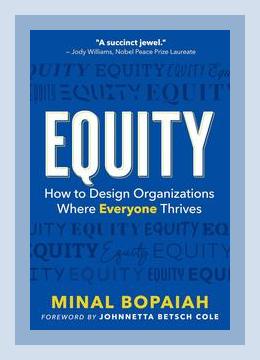Human Resources and Talent ManagementDiversity and Inclusion
Introduction
Equity: How to Design Organizations Where Everyone Thrives by Minal Bopaiah is a seminal work on diversity, inclusion, and equity within organizations. Bopaiah provides a framework for understanding and implementing equity, using research, real-life examples, and actionable steps. The book redefines traditional organizational structures and strategies for a more inclusive approach where every individual can thrive.
Chapter 1: Understanding Equity
Major Points
- Distinguishing Equity from Equality: Equality means treating everyone the same, while equity involves recognizing and addressing differences to ensure everyone has access to the same opportunities.
- Historical Context: The systemic biases and structural inequalities that exist today are rooted in a historical context.
Actions
- Education Programs: Implement educational programs to inform employees about the historical context of systemic biases.
- Example: Regular workshops on the history of racial and gender inequality.
Chapter 2: The Business Case for Equity
Major Points
- Enhanced Innovation: Diverse teams are more innovative and can solve problems more effectively due to varied perspectives.
- Market Growth: Companies with diverse workforces are better positioned to understand and cater to a diverse customer base.
Actions
- Diverse Hiring Practices: Actively seek to hire a diverse workforce to foster innovation and growth.
- Example: Implement inclusive recruitment practices that reach out to underrepresented communities.
Chapter 3: Organizational Culture and Social Identity
Major Points
- Influence of Social Identity: Social identity shapes our experiences and perspectives in the workplace.
- Inclusive Culture: It’s crucial to create a culture where all social identities are respected and included.
Actions
- Inclusive Leadership Training: Conduct training for leaders on how to foster an inclusive culture that respects various social identities.
- Example: Workshops teaching leaders about the impact of social identity on workplace dynamics.
Chapter 4: Structural Changes for Equity
Major Points
- Policy Revisions: Review and revise organizational policies to eliminate biases and promote equity.
- Equitable Opportunities: Ensure that opportunities for advancement and development are equitably distributed.
Actions
- Audit Policies: Regularly review policies and procedures to ensure they promote equity.
- Example: Conduct a bias audit of existing policies and make necessary amendments.
Chapter 5: Measuring Equity
Major Points
- Developing Metrics: Establish specific, measurable metrics to assess equity within the organization.
- Transparency in Reporting: Regularly report on equity metrics to maintain transparency and accountability.
Actions
- Equity Dashboard: Create a dashboard that tracks and displays key equity metrics.
- Example: A publicly accessible equity dashboard that tracks hiring, promotion rates, and salary equity.
Chapter 6: Role of Leadership
Major Points
- Commitment from the Top: Leadership must be committed to equity for any initiative to be successful.
- Lead by Example: Leaders should model equitable behaviors and practices.
Actions
- Equity Pledge: Leaders should make a public commitment to equity.
- Example: A formal equity pledge signed by all C-suite executives.
Chapter 7: The Importance of Allies
Major Points
- Allyship: Allies play a crucial role in supporting underrepresented groups and advocating for equity.
- Education and Engagement: Allies need to be educated about the struggles of marginalized groups to be effective.
Actions
- Ally Training Programs: Develop programs that train employees to be effective allies.
- Example: Regular allyship training sessions focusing on listening, support, and advocacy.
Chapter 8: Communication Strategies
Major Points
- Inclusive Language: Use inclusive language that respects all identities.
- Open Dialogue: Foster an environment where open, honest dialogue about equity is encouraged.
Actions
- Inclusive Communication Guidelines: Develop guidelines to ensure all communication is inclusive.
- Example: A communication manual that advises on inclusive language practices.
Chapter 9: Overcoming Resistance
Major Points
- Understanding Resistance: Resistance to equity initiatives often comes from a place of fear or misunderstanding.
- Addressing Concerns: Addressing these concerns openly can help mitigate resistance.
Actions
- Feedback Mechanisms: Implement feedback mechanisms to understand and address concerns related to equity initiatives.
- Example: Anonymous surveys to gather honest feedback on equity initiatives.
Chapter 10: Case Studies
Major Points
- Real-World Examples: Case studies of organizations that have successfully implemented equity initiatives provide practical insights and inspiration.
Actions
- Learning from Others: Study successful case studies to identify best practices and potential pitfalls.
- Example: Monthly learning sessions discussing different case studies from the book.
Conclusion
Minal Bopaiah’s Equity not only outlines the necessity and benefits of equitable practices in organizations but also provides actionable steps to achieve it. By understanding the distinction between equality and equity, committing to inclusive practices, and fostering a supportive culture, organizations can ensure that everyone thrives.
Summarization
- Understanding and Education: Start with creating awareness about the historical and social contexts of inequity through education programs.
- Business Incentives: Recognize and advocate the business benefits of equity, such as enhanced innovation and market growth, by diversifying hiring practices.
- Inclusive Culture: Cultivate an inclusive culture that respects social identities, beginning with inclusive leadership training.
- Policy and Structure: Regularly audit and adjust organizational policies to promote and ensure equity, focusing on equitable opportunities.
- Measurement and Accountability: Implement and monitor equity metrics through a transparent equity dashboard.
- Leadership Commitment: Ensure leadership models and commits to equity through public pledges.
- Role of Allies: Educate and engage allies within the organization to support equity initiatives.
- Effective Communication: Develop and follow inclusive communication strategies.
- Overcoming Resistance: Foster open dialogues and address concerns through feedback mechanisms.
- Learn from Examples: Continuously learn from real-world case studies and best practices to guide and refine equity efforts.
Bopaiah’s book is a comprehensive guide that emphasizes practical steps and real-world applications, making it an invaluable resource for anyone looking to make meaningful changes in organizational equity.
Human Resources and Talent ManagementDiversity and Inclusion
